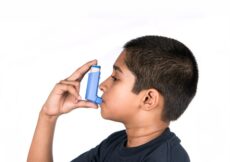New research from the Case Western Reserve University (CWRU) School of Medicine suggests that the children younger than age 5 who are infected with the COVID-19 Omicron variant have less risk of severe health outcomes than those infected with the Delta variant.
The study, published Friday in JAMA Pediatrics, is the first large-scale research effort to compare the health outcomes of coronavirus infection from Omicron to Delta in children 4 and younger-; the age group not yet able to be vaccinated.
The findings show that the Omicron variant is 6-8 times more infectious than the Delta variant. The severe clinical outcomes ranged from a 16% lower risk for emergency room visits to 85% less risk for mechanical ventilation. And about 1.8% of children infected with Omicron were hospitalized, compared to 3.3% with Delta.
The Case Western Reserve-led team analyzed the electronic health records of more than 651,640 children in the United States who had medical encounter with healthcare organizations between 9/2021-1/2022–including more than 22,772 children infected with Omicron in late December and late January-;to more than 66,000 children infected when Delta was prevalent in the fall. The study also compared the records of more than 10,000 children immediately before the detection of Omicron in the U.S., but when Delta was still predominant.
Children younger than 5 are not yet eligible for COVID-19 vaccines and have a low rate of previous SARS-CoV-2 infections, which also limits their pre-existing immunity.
The team examined clinical health outcomes for pediatric patients during a 14-day window following SARS-CoV-2 infection. Among the factors they reviewed were: emergency room visits, hospitalizations, ICU admissions and mechanical ventilation use.
Further demographic data analysis found that children infected with Omicron were on average younger–1.5 years of age versus 1.7 years–and had fewer comorbidities.
The major conclusion to our research was that many more children were infected with Omicron when compared to Delta, but the children who are infected are not impacted as severely as were children infected with the Delta variant. However, because there are so many more children infected, our hospitals were affected over the winter months by an influx of young children.”
Pamela Davis, the Arline H. and Curtis F. Garvin Research Professor, Case Western Reserve School of Medicine
“We saw the number of hospitalizations within this age group skyrocket in January of this year because the infection rate of Omicron is about 10 to 15 times compared to that of the Delta variant,” said Rong Xu, professor of biomedical infomatics and director of the Center for AI in Drug Discovery at the School of Medicine. “Omicron is less severe than Delta, however, the reduction of the severity range in clinical outcomes is only 16 to 85%. Furthermore, since so many un-vaccinated children were infected, the long-term effects of COVID-19 infections on the brain, heart, immune systems and other organs of children remains unknown and worrisome. “
The CDC recommends those age 5 and older receive a COVID-19 vaccine, and fully vaccinated people 12 and older receive a booster shot. According to updated guidance by the CDC, Americans no longer need to mask indoors in counties with low or medium “Covid-19 Community Level.”
Source:
Case Western Reserve University
Journal reference:
Wang, L., et al. (2022) Incidence Rates and Clinical Outcomes of SARS-CoV-2 Infection With the Omicron and Delta Variants in Children Younger Than 5 Years in the US. JAMA Pediatrics. doi.org/10.1001/jamapediatrics.2022.0945.



































